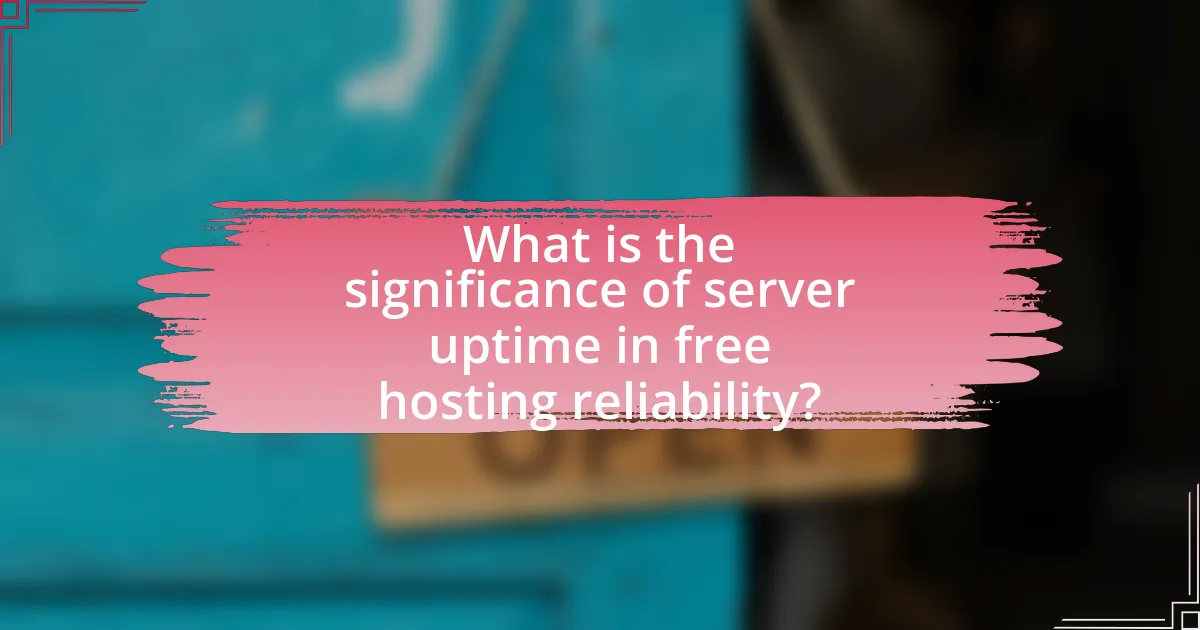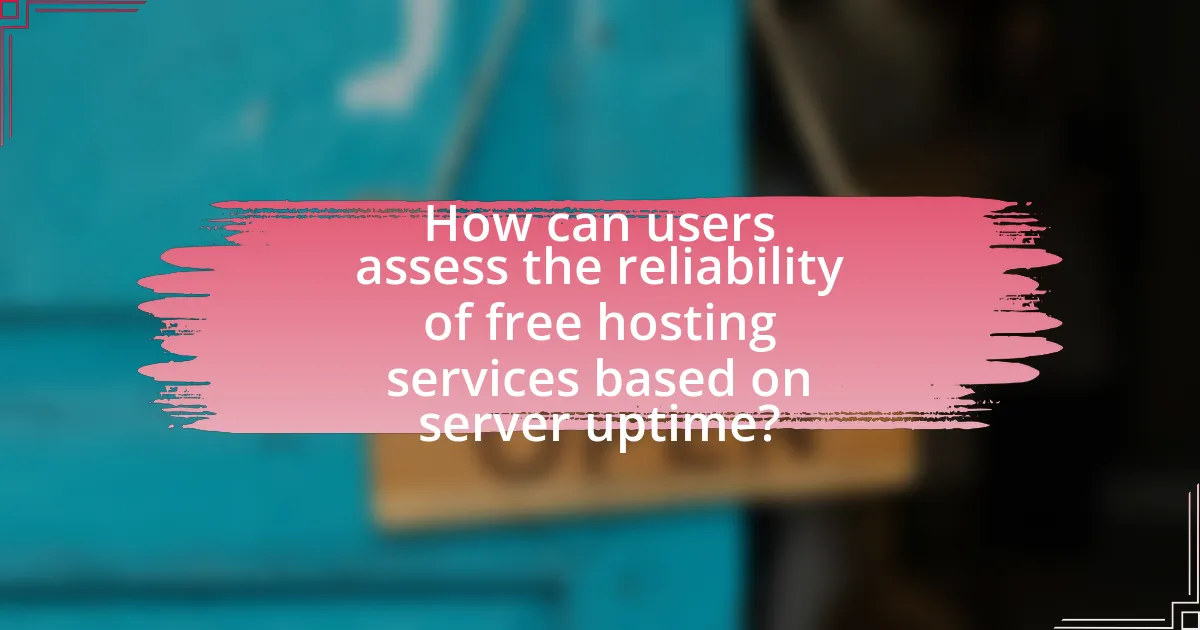The article focuses on the significance of server uptime in determining the reliability of free hosting services. It highlights how high server uptime, typically above 99.9%, is essential for maintaining website accessibility, user trust, and engagement, while low uptime can lead to frequent downtimes and negative user experiences. Key metrics for measuring server uptime, such as availability percentage and mean time between failures, are discussed, along with the impact of downtime on businesses and website traffic. Additionally, the article examines factors contributing to server uptime, common causes of downtime, and best practices for users to enhance reliability in free hosting environments.

What is the significance of server uptime in free hosting reliability?
Server uptime is crucial for free hosting reliability as it directly affects the availability and performance of hosted websites. High server uptime ensures that websites remain accessible to users, which is essential for maintaining user trust and engagement. According to a study by HostingAdvice, reliable hosting services typically achieve uptime rates of 99.9% or higher, while free hosting services often struggle to meet these standards due to limited resources and support. Consequently, low server uptime in free hosting can lead to frequent downtimes, negatively impacting user experience and potentially resulting in lost traffic and revenue for website owners.
How does server uptime influence the performance of free hosting services?
Server uptime directly influences the performance of free hosting services by determining the availability and reliability of websites hosted on those platforms. High server uptime, typically above 99.9%, ensures that websites remain accessible to users without interruptions, which is crucial for maintaining user engagement and satisfaction. Conversely, low uptime can lead to frequent outages, resulting in lost traffic and diminished trust in the service. For instance, a study by HostingAdvice found that free hosting services often experience uptime rates as low as 90%, significantly impacting website performance and user experience. Therefore, consistent server uptime is essential for the effective operation of free hosting services.
What metrics are used to measure server uptime?
The primary metrics used to measure server uptime are availability percentage, mean time between failures (MTBF), and mean time to repair (MTTR). Availability percentage quantifies the total operational time of a server compared to the total time it should be operational, often expressed as a percentage; for example, a server with 99.9% uptime is down for approximately 8.76 hours per year. MTBF measures the average time a server operates before experiencing a failure, indicating reliability, while MTTR assesses the average time taken to restore service after a failure, reflecting the efficiency of recovery processes. These metrics are critical for evaluating server performance and reliability in hosting environments.
How does downtime affect user experience on free hosting platforms?
Downtime significantly deteriorates user experience on free hosting platforms by causing website inaccessibility and frustration. When users encounter downtime, they are unable to access content or services, leading to dissatisfaction and potential loss of trust in the platform. Research indicates that 47% of users expect a website to load in two seconds or less, and any delay can result in increased bounce rates. Furthermore, prolonged downtime can lead to negative perceptions of reliability, ultimately affecting user retention and engagement.
Why is server uptime critical for businesses using free hosting?
Server uptime is critical for businesses using free hosting because it directly affects their online availability and reliability. High uptime ensures that a business’s website is accessible to customers at all times, which is essential for maintaining customer trust and engagement. According to a study by Gartner, even a minute of downtime can cost businesses thousands of dollars in lost revenue and damage to reputation. Therefore, consistent server uptime is vital for free hosting services to support business operations effectively.
What are the potential risks of low server uptime for small businesses?
Low server uptime poses significant risks for small businesses, primarily leading to lost revenue and diminished customer trust. When servers are frequently down, businesses experience interruptions in service, which can result in direct financial losses; for instance, a study by the Aberdeen Group found that downtime can cost businesses an average of $260,000 per hour. Additionally, low uptime can damage a company’s reputation, as customers may turn to competitors if they encounter unreliable service. This erosion of trust can have long-term effects on customer retention and brand loyalty, ultimately impacting overall business growth.
How can server uptime impact website traffic and engagement?
Server uptime directly influences website traffic and engagement by determining the availability of the site to users. High server uptime ensures that a website is accessible, which leads to increased visitor numbers and prolonged user interaction. For instance, a study by Google found that a one-second delay in page load time can result in a 20% decrease in traffic. Conversely, consistent uptime fosters user trust and encourages repeat visits, as users are more likely to engage with a site that is reliably available. Therefore, maintaining high server uptime is crucial for maximizing both traffic and user engagement.

What factors contribute to server uptime in free hosting environments?
Server uptime in free hosting environments is primarily influenced by resource allocation, server maintenance, and network reliability. Resource allocation affects how much CPU, memory, and bandwidth are available to each user, which can lead to performance issues if not managed properly. Regular server maintenance, including software updates and hardware checks, ensures that potential issues are addressed before they lead to downtime. Network reliability is crucial, as consistent internet connectivity and minimal latency contribute to overall uptime. Studies have shown that free hosting services often experience higher downtime rates due to limited resources and less frequent maintenance compared to paid services, highlighting the importance of these factors in determining uptime.
How do server infrastructure and technology affect uptime?
Server infrastructure and technology significantly influence uptime by determining the reliability and performance of hosting services. High-quality hardware, such as redundant power supplies and advanced cooling systems, minimizes the risk of failures, while robust network architecture ensures consistent connectivity. For instance, data centers with multiple internet connections can reroute traffic in case of an outage, enhancing overall uptime. Additionally, the use of virtualization technology allows for better resource allocation and load balancing, which can prevent server overloads. According to a study by the Uptime Institute, facilities with tiered infrastructure designs experience 99.99% uptime, demonstrating the direct correlation between infrastructure quality and service reliability.
What role do data centers play in maintaining server uptime?
Data centers play a critical role in maintaining server uptime by providing a controlled environment with redundant systems for power, cooling, and connectivity. These facilities are designed to minimize downtime through features such as uninterruptible power supplies (UPS), backup generators, and advanced cooling systems that prevent overheating. According to the Uptime Institute, data centers with redundant infrastructure can achieve uptime levels of 99.999%, significantly reducing the risk of server outages. This reliability is essential for free hosting services, as consistent server uptime directly impacts user experience and trust in the service.
How does redundancy in server systems enhance uptime reliability?
Redundancy in server systems enhances uptime reliability by providing backup components that can take over in case of failure. When a primary server fails, redundant systems, such as additional servers or failover mechanisms, ensure that services remain operational without interruption. For instance, a study by the Uptime Institute found that organizations implementing redundancy can achieve uptime rates exceeding 99.99%, significantly reducing the risk of downtime. This capability to maintain continuous service is crucial for free hosting reliability, as it minimizes disruptions for users and ensures consistent access to hosted content.
What are the common causes of server downtime in free hosting?
Common causes of server downtime in free hosting include limited resources, lack of technical support, and server overload. Limited resources often lead to insufficient bandwidth and storage, which can cause websites to become unresponsive during peak traffic times. The absence of technical support means that issues may not be resolved promptly, prolonging downtime. Additionally, server overload occurs when too many users share the same server, resulting in performance degradation and potential crashes. These factors collectively contribute to the unreliability of free hosting services.
How do software issues lead to server outages?
Software issues lead to server outages primarily through bugs, misconfigurations, and resource exhaustion. Bugs in the code can cause unexpected behavior, leading to crashes or unresponsiveness. Misconfigurations, such as incorrect settings in server software or network configurations, can prevent servers from functioning correctly. Resource exhaustion occurs when software fails to manage memory or processing power effectively, resulting in overloads that can crash the server. For instance, a study by the Ponemon Institute found that 60% of downtime incidents are attributed to software failures, highlighting the significant impact of software issues on server reliability.
What external factors can contribute to server downtime?
External factors that can contribute to server downtime include natural disasters, power outages, network failures, and cyberattacks. Natural disasters such as earthquakes or floods can physically damage server infrastructure, leading to outages. Power outages disrupt the electricity supply necessary for server operation, while network failures can occur due to issues with internet service providers or hardware malfunctions, affecting connectivity. Cyberattacks, including Distributed Denial of Service (DDoS) attacks, can overwhelm servers, rendering them inaccessible. These factors collectively highlight the vulnerabilities that external conditions impose on server reliability.

How can users assess the reliability of free hosting services based on server uptime?
Users can assess the reliability of free hosting services based on server uptime by examining uptime guarantees and historical performance data. Uptime guarantees, often expressed as a percentage, indicate the expected operational time of the server; for example, a 99.9% uptime guarantee suggests minimal downtime. Historical performance data can be obtained from independent monitoring services that track server uptime over time, providing insights into actual performance versus promised uptime. Additionally, user reviews and testimonials can offer anecdotal evidence of reliability, highlighting experiences with downtime or service interruptions.
What tools and resources are available for monitoring server uptime?
Tools and resources available for monitoring server uptime include uptime monitoring services like Pingdom, UptimeRobot, and StatusCake. These services provide real-time monitoring of server availability and performance, alerting users to downtime through various channels such as email or SMS. For instance, Pingdom offers a 99.9% uptime guarantee and monitors over 70 locations worldwide, ensuring comprehensive coverage. UptimeRobot allows users to monitor up to 50 sites for free, checking every five minutes, which is beneficial for small businesses or personal projects. StatusCake provides advanced features like page speed monitoring and SSL certificate checks, enhancing overall server management. These tools are essential for maintaining reliability in free hosting environments, where uptime directly impacts user experience and service credibility.
How can uptime statistics influence the choice of a free hosting provider?
Uptime statistics significantly influence the choice of a free hosting provider by indicating the reliability and performance of the service. High uptime percentages, typically above 99%, suggest that the hosting provider maintains consistent server availability, which is crucial for ensuring that websites remain accessible to users. For instance, a provider boasting a 99.9% uptime translates to approximately 8.76 hours of downtime annually, while a provider with 95% uptime could result in over 18 days of downtime in the same period. Therefore, potential users should prioritize uptime statistics when selecting a free hosting provider to avoid disruptions that could negatively impact their online presence and user experience.
What should users look for in uptime guarantees from free hosting services?
Users should look for a minimum uptime guarantee of 99.9% from free hosting services. This percentage indicates that the service is reliable, as it allows for only about 40 minutes of downtime per month. Additionally, users should verify the provider’s historical uptime performance, as consistent uptime records can demonstrate reliability. Many reputable free hosting services publish their uptime statistics, which can serve as proof of their commitment to maintaining service availability.
What best practices can enhance server uptime for free hosting users?
To enhance server uptime for free hosting users, implementing regular backups is essential. Regular backups ensure that data can be restored quickly in case of server failures, minimizing downtime. Additionally, users should monitor server performance using available tools to identify issues proactively. Research indicates that proactive monitoring can reduce downtime by up to 30% by allowing users to address potential problems before they escalate. Furthermore, optimizing website code and minimizing resource-heavy plugins can significantly improve server response times, contributing to overall uptime. These practices collectively support a more reliable hosting experience for users relying on free services.
How can regular maintenance improve server reliability?
Regular maintenance significantly improves server reliability by identifying and resolving potential issues before they escalate into failures. Scheduled updates, hardware checks, and software optimizations ensure that servers operate efficiently and securely. For instance, a study by the Uptime Institute found that organizations that implement regular maintenance practices experience 50% fewer outages compared to those that do not. This proactive approach minimizes downtime, enhances performance, and ultimately leads to a more dependable hosting environment.
What proactive measures can users take to mitigate downtime risks?
Users can mitigate downtime risks by implementing regular backups, utilizing monitoring tools, and ensuring redundancy in their systems. Regular backups protect data integrity and allow for quick recovery in case of failure, with studies showing that 60% of companies that lose their data will shut down within six months. Monitoring tools provide real-time alerts for performance issues, enabling users to address problems before they escalate. Additionally, redundancy, such as having multiple servers or failover systems, ensures that if one component fails, another can take over, significantly reducing the likelihood of downtime.















